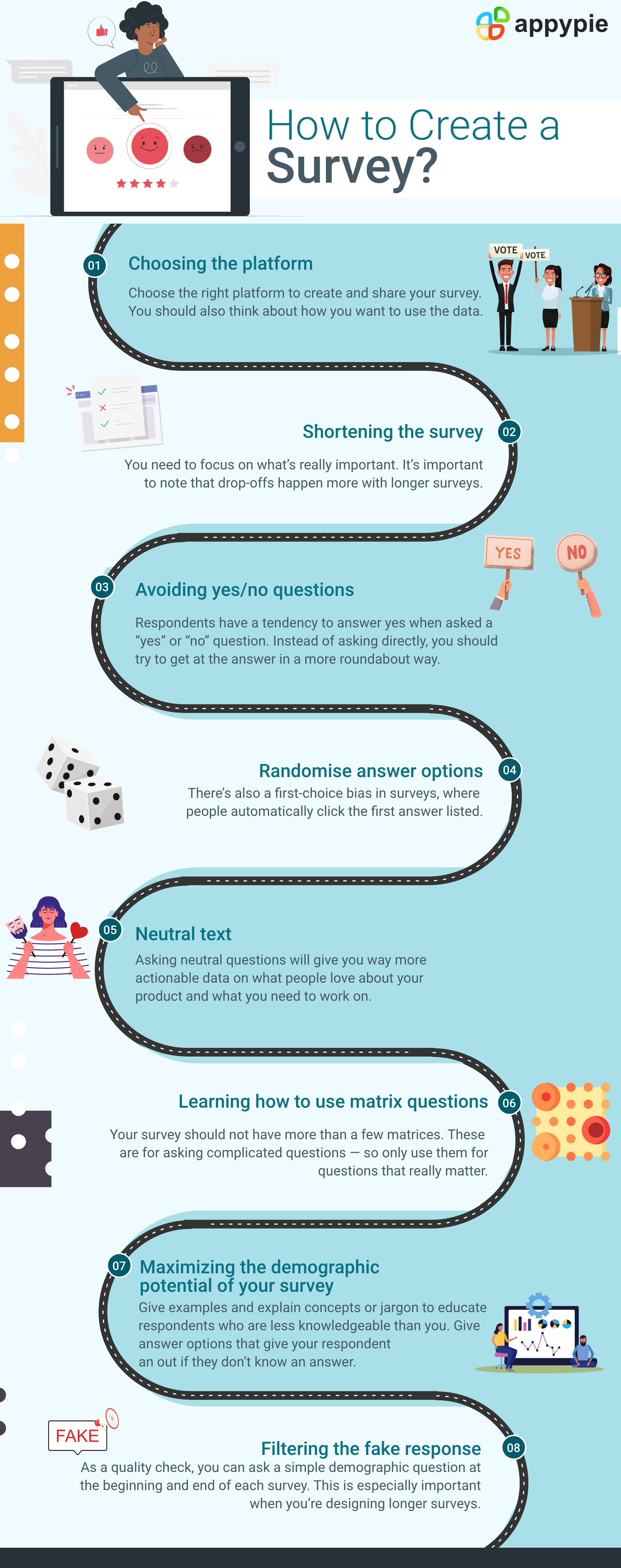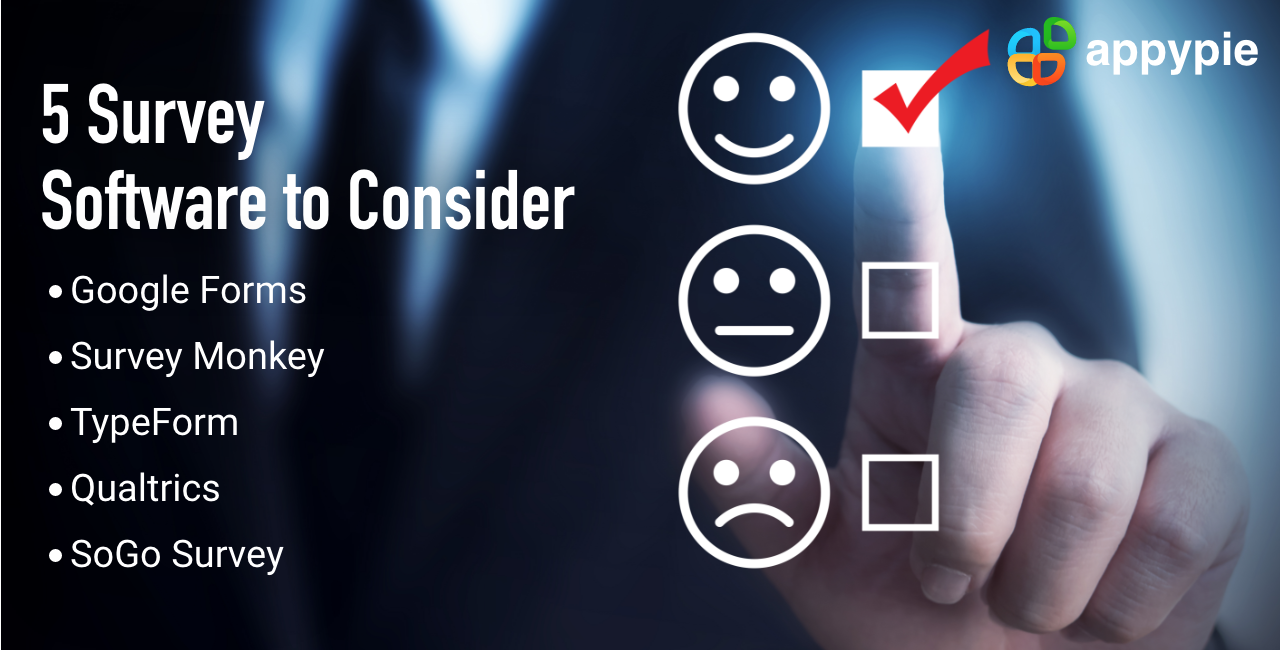A Beginner’s Guide to Create a Great Survey [+7 Survey Platforms to Consider]

By Abhinav Girdhar | Last Updated on May 8th, 2024 1:04 pm | 4-min read
Table of Content
Introduction
I often get emails asking me to participate in surveys. Being the good samaritan that I am, I often respond to them. However, one thing that grinds my gears is how bad some surveys are. They aren’t rocket science in any way but the sheer amount of bad surveys one can find is the reason why many people ignore surveys. Seeing this, I’ve decided to write a blog on how to create a survey that people actually want to take. What this blog aims to provide is a basic guideline/checklist and a set of universal rules that you must follow while creating a survey. We have listed the steps in an organized fashion. Let us talk no more and jump right into it.
The Philosophy Behind Surveys
You must be wondering why surveys are important to your business. There’s a very simple philosophy behind the ‘why’ of surveys. Surveys provide information that you need. What sets surveys apart is that unlike other sources of information surveys are the most comfortable for your users and they are more likely to provide honest answers in surveys.Without data, you’re just another person with an opinion.
How to Create a Survey?
Given below is a step-by-step guide on creating a survey.Step 1: Choosing a Platform: The first step to creating a survey is choosing a platform. Each survey platform is different but apart from the interface most tend to fulfil the needs you have. Choose the one you think is best. A list of survey making software has been given later in the blog.Step 2: Shortening the Survey: Once you have chosen a platform, the quest for making the perfect survey begins. Deciding on the questions depends on the purpose of your survey. Once you have created a list of questions, add them to your survey-making application. Then you begin the first activity for your survey. Cut the unnecessary weight off. The only thing more infuriating than a bad survey is a long survey. Whatever questions that seem irrelevant to your end goal must be removed. Trimming your survey makes it more focused. Do not try to get too much data from one survey. You need to ensure that your survey respondents complete the survey. The only way to ensure that is to make your survey short, sweet, and effective.Step 3: Avoiding Yes/No Questions: These questions are more likely to be deleted from your survey. It is a popular belief that users are more likely to answer yes and no questions. While the belief has some merit to it, respondents have a bias to answer yes even when they should be answering no. In addition, too many yes and no questions add unnecessary weight to the survey and don’t provide many rewards for it. Diversify your survey and include other types of questions. Survey software can provide more than 100 answers.Step 4: Randomizing Answers: If your survey is meant for feedback or proper insight, it is better to randomize answers. To avoid fake responses, and people just wanting to randomly get through and be done with it, make sure you randomize your answers. This can help you weed out fake responders based on answer patterns and find out which people were actually serious about taking your survey.Step 5: Neutral text ftw (for the win): Don’t ask the questions that lead users on. For example, if you want a responder’s take on a product named X, don’t ask, “why do you like x?” This might work for your internal requirements but survey results are usually publicised and questions like this might create doubt for your authenticity. Instead ask users “How would you rate X on a scale of 1-10?” Based on how they respond, you can then ask them to elaborate on why they gave their rating. Always keep your text neutral. Take the help of your content team to develop questions for the surveys since they generally have a good experience when it comes to keeping text neutral. Before your survey goes live, review each question and response to ensure that neutral text is maintained.Step 6: Learning How to Use Matrix Questions: Matrix questions are one of the best question formats present in a survey. They simplify complex questions and provide some of the best insights into the responders. However, despite their usefulness, matrix questions should only be limited to one or two per survey. Matrix questions are likely to demoralize your responders since they take time to fill. To ensure that they complete the survey, keep your matrix questions towards the end of the survey and limit the number of matrices you add. The less, the better. Another thing to remember is that you should limit the number of options you provide in the matrices. Too many options can be terrifying and demotivating.Step 7: Maximizing the Demographic Potential of Your Survey: Simplify your language. Not all your customers are industry experts like you. To ensure you get respondents from every customer base, design the survey to reflect most of them. A simple example would be asking the gender of a person. You may include man or woman as the option but they may not identify as any of them. This would both increase the number of people who leave your survey or skew your results in a direction that is not correct. Provide all possible options that make sense to maximize the demographic of your customer base.Step 8: Filtering fake respondents: Filtering fake respondents is important to ensure the most authentic answer base possible. You can filter said respondents with the help of ‘red herring’ questions. The red herring question can be anything. You could ask the nationality of the person, or their employee strength. This helps you weed out respondents that are answering questions randomly. Having a safety net against fake respondents maintains the authenticity of your survey.7 Survey Making Software to Consider
Now that you know the guidelines to follow while creating a survey, here is our list of 7 survey making software that you should consider for your activities.- Pointerpro: Want to scale your business, generate leads, or save time? Pointerpro makes things easier. Create your own online assessments and automatically provide respondents with personalized reports. Turn your expertise into a tool that delivers individualized advice at scale.
- Google Forms: Google Forms is one of the simplest survey software tools out there. It’s not the most extensive tool but it is an excellent choice for small businesses. It comes as a part of the GSuite.
- Qualaroo: Qualaroo is one of the best NPS tools for measuring customer satisfaction (CSAT) and gaining insights to reduce customer churn by deploying surveys through web browsers, links, emails, in-app, and more channels. It allows users to deploy NPS surveys as a part of their voice of customer research to determine the overall brand perception, customer satisfaction, and impact of marketing strategies.
- Survey Monkey: Survey Monkey has been consistently rated as one of the best surveying tools on the Internet. Used by millions of businesses worldwide, Survey Monkey is your choice if you want a safe, tried, and tested software.
- TypeForm: Type Form is an open-source survey software that provides a core plan free of cost. It has a user-friendly interface and some of the best features that are available for free. However, TypeForm limits the number of responses per survey and provides a subscription model for unlimited responses.
- Qualtrics: Qualtrics is vast. It provides over 100 types of questions that can be asked to a respondent. It has features that blow the competition out of the water and one of the best graph reports & analytics of any survey software.
- SoGo Survey: An affordable to have, SoGo Survey provides an excellent and easy-to-use template-based themes and questions. It can help organize surveys based on various parameters including NPS, demographics and text. SoGo is a great option for policymakers and researchers.
- Opinion Stage: Opinion Stage is a service for creating interactive & visual quizzes, polls, surveys, and forms. Marketers and publishers use Opinion Stage to boost engagement, generates leads, drives revenue, gather actionable insights & more.
- Zonka Feedback: Zonka Feedback is an easy-to-use Survey and Feedback Management Software that helps create smart surveys with real-time alerts and notifications. The software enables brands to collect feedback throughout the customer journey across various channels like email, SMS, website, mobile app, phone, tablet, kiosk, QR code, etc.
Conclusion
That was it for our how to create a survey blog. I hope you had a good learning experience with this blog. If you are a brand or company that does surveys on the regular, there’s a new option for you. Do surveys anytime you want with your very own survey app. You can create a survey app using Appy Pie’s Survey App Builder. It's completely no code which means that you do need prior coding experience to create an app. Have Fun!Citations
Snap SurveyCapterramopinion.comRelated Articles
- 15 Effective Ways To Increase Your Food Delivery Sales
- Silver Color: Exploring Hues and Hex Codes
- Create Passport Size Photos Online: A Complete Guide By Countries
- How to Buy NFTs? A Step-by-Step Guide
- 20 Best SEO Tools for Better Google Ranking in 2022
- The Internet of Things and the Power of Connectivity (Podcast 106)
- Mastering Machine Learning Operations (MLOps)
- Mastering Cold Calling: A Beginner’s Guide
- ClickUp vs. Monday.com: Which is the Best Project Management Solution in 2024?
- Why Can’t You Copy and Paste in Google Docs? An In-Depth Look

